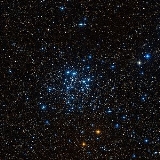
NGC 663
Encyclopedia
NGC 663, also known as Caldwell 10, is young open cluster
of about 400 stars in the Cassiopeia constellation. It has an estimated 400 stars and spans about a quarter of a degree across the sky. It can reportedly be detected with the unaided eye, although a telescope is recommended for best viewing. The brightest members of the cluster can be viewed with binoculars. Although the listed visual magnitude is 7.1, several observers have reported higher estimates.
After adjusting for reddening due to interstellar dust, the distance modulus
is estimated as 11.6 magnitudes. It is located about 2,100 parsecs distant with an estimated age of 20–25 million years. This means that stars of spectral class B2 or higher (in the sense of higher mass), are reaching the end of their main sequence
lifespan. This cluster appears to be located in front of a molecular cloud
, although the two are not physically associated. This cloud has the effect of blocking background stars from the visual image of the cluster as it lies at a distance of 300 parsecs.
This cluster is of interest because of the high number of Be star
s, with a total of about 24 discovered. These are spectral class B stars that show prominent emission lines of hydrogen
in their spectrum. Most of the Be stars in the cluster lie between spectral class B0 and B3. A candidate member of the cluster, LS I +61° 235, is a Be star with an X-ray
binary component that has a period of about three years. There are at least five blue straggler
s in the cluster. These are stars that formed by the merger of two other stars. Two of the cluster's star systems are likely eclipsing binaries with periods of 0.6 and 1.03 days.
Open cluster
An open cluster is a group of up to a few thousand stars that were formed from the same giant molecular cloud and have roughly the same age. More than 1,100 open clusters have been discovered within the Milky Way Galaxy, and many more are thought to exist...
of about 400 stars in the Cassiopeia constellation. It has an estimated 400 stars and spans about a quarter of a degree across the sky. It can reportedly be detected with the unaided eye, although a telescope is recommended for best viewing. The brightest members of the cluster can be viewed with binoculars. Although the listed visual magnitude is 7.1, several observers have reported higher estimates.
After adjusting for reddening due to interstellar dust, the distance modulus
Distance modulus
-Definition:The distance modulus \mu=m-M is the difference between the apparent magnitude m and the absolute magnitude M of an astronomical object...
is estimated as 11.6 magnitudes. It is located about 2,100 parsecs distant with an estimated age of 20–25 million years. This means that stars of spectral class B2 or higher (in the sense of higher mass), are reaching the end of their main sequence
Main sequence
The main sequence is a continuous and distinctive band of stars that appears on plots of stellar color versus brightness. These color-magnitude plots are known as Hertzsprung–Russell diagrams after their co-developers, Ejnar Hertzsprung and Henry Norris Russell...
lifespan. This cluster appears to be located in front of a molecular cloud
Molecular cloud
A molecular cloud, sometimes called a stellar nursery if star formation is occurring within, is a type of interstellar cloud whose density and size permits the formation of molecules, most commonly molecular hydrogen ....
, although the two are not physically associated. This cloud has the effect of blocking background stars from the visual image of the cluster as it lies at a distance of 300 parsecs.
This cluster is of interest because of the high number of Be star
Be star
A Be star is a B-type star with prominent emission lines of hydrogen in its spectrum. The designation is combined by the spectral class, B, and the lowercase e denoting emission in the spectral classification system. Line emission from other atomic ions might be present as well, but is typically...
s, with a total of about 24 discovered. These are spectral class B stars that show prominent emission lines of hydrogen
Hydrogen
Hydrogen is the chemical element with atomic number 1. It is represented by the symbol H. With an average atomic weight of , hydrogen is the lightest and most abundant chemical element, constituting roughly 75% of the Universe's chemical elemental mass. Stars in the main sequence are mainly...
in their spectrum. Most of the Be stars in the cluster lie between spectral class B0 and B3. A candidate member of the cluster, LS I +61° 235, is a Be star with an X-ray
X-ray
X-radiation is a form of electromagnetic radiation. X-rays have a wavelength in the range of 0.01 to 10 nanometers, corresponding to frequencies in the range 30 petahertz to 30 exahertz and energies in the range 120 eV to 120 keV. They are shorter in wavelength than UV rays and longer than gamma...
binary component that has a period of about three years. There are at least five blue straggler
Blue straggler
Blue stragglers are main sequence stars in open or globular clusters that are more luminous and bluer than stars at the main sequence turn-off point for the cluster. Blue stragglers were first discovered by Allan Sandage in 1953 while performing photometry of the stars in the globular cluster M3...
s in the cluster. These are stars that formed by the merger of two other stars. Two of the cluster's star systems are likely eclipsing binaries with periods of 0.6 and 1.03 days.

